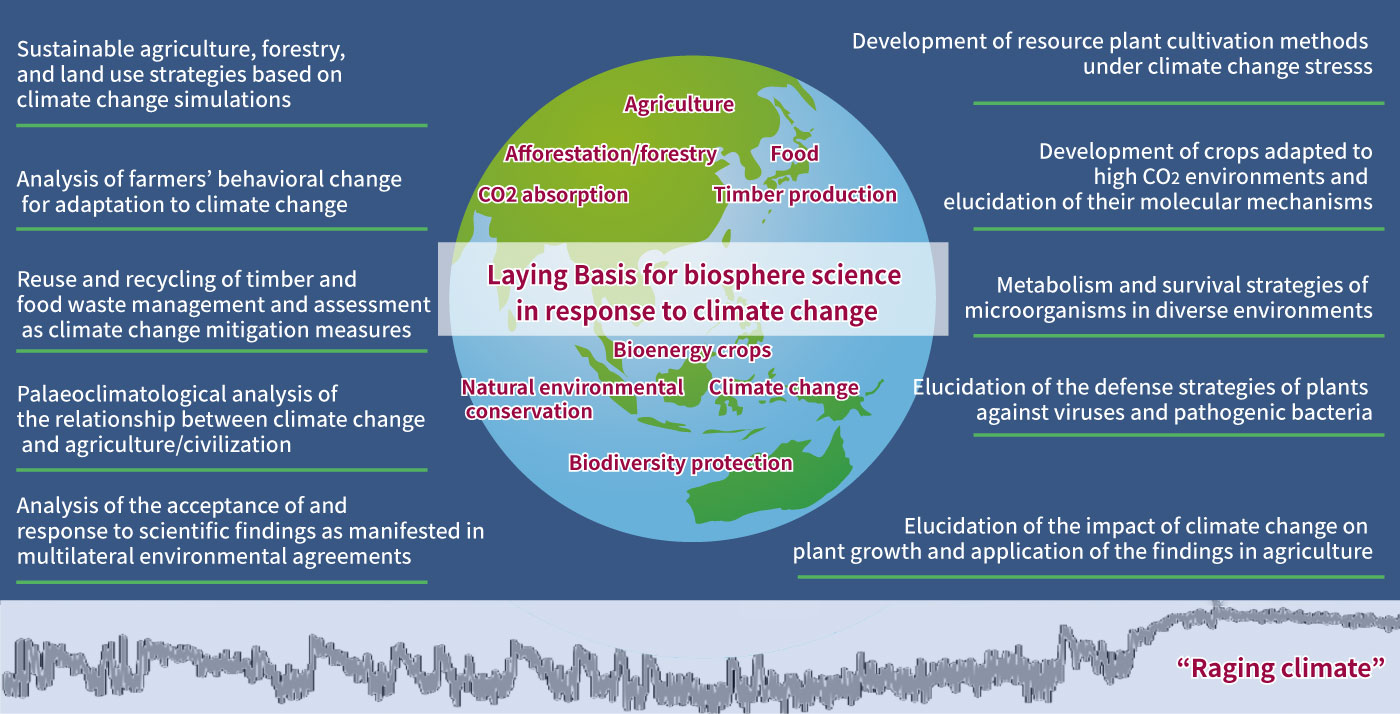Research AreaⅠ Restoration of the Earth's natural environmentBasis for Biosphere Science in Response to Climate Change
Sustainable strategies and a technological basis for solving major issues in the next 100 years
Leaders
-
Project leaderHisaaki MiharaProfessor, Department of Biotechnology, College of Life SciencesProfile
-
-
Group leaderTakeshi IshimizuProfessor, Department of Biotechnology, College of Life SciencesProfile
-
Group leaderHiroyoshi MatsumuraProfessor, Department of Biotechnology, College of Life SciencesProfile
-
Group leaderYoichiro FukaoProfessor, Department of Bioinformatics, College of Life SciencesProfile
Multidisciplinary approach to climate change-related challenges Creating a new academic discipline, climate change-responsive biosphere science
The objective of this research project is to develop sustainable strategies and a technological basis for solving major planet-scale issues that should be addressed in the next 100 years (“100-year themes”), as climate change is causing extreme phenomena with increasing frequency that can be collectively referred to as “raging climate.” For this project, we have identified as the “100-year themes” agriculture, food, afforestation/forestry, timber production, CO2 absorption, bioenergy crops, natural environmental conservation, climate change, and biodiversity protection. We address these issues with knowledge and expertise from diverse fields, such as plant science, agriculture, microbiology, paleoclimatology, agricultural economics, and international law.
The primary strength of this project is the participation of researchers as project members whose research achievements in their respective fields are at the forefront in the world. The members bring together, develop, and refine their knowledge and expertise from their areas of specialization, with their different cultures, for the solving of common problems. In this process, we attempt to establish a new academic discipline: climate change-responsive biosphere science, encompassing a broad range of academic fields related to science and technology, the economy, society, and international law and policy making, which are explored in responding to climate change. Understanding the term “biosphere” as a multi-scale, multi-layered structure comprising all life forms and their activities, from molecules and microorganisms to humans and ecosystems, we attempt to clarify their interactions on a time axis from ancient times to the future to construct a foundation for addressing major issues covering a broad range of fields.
-

Research results envisaged in this project
Multi-scale research from climate change simulation and genetic- and molecular-level analysis to practical application of agricultural technologies
Toward these objectives, five groups of researchers pursue the project by working toward their respective goals. Firstly, the Hasegawa Group’s goal is to formulate and propose strategies that enable sustainable agriculture, forestry, and land use based on climate change-related simulations. By using several internationally recognized simulation models, such as the Global Computable General Equilibrium Model and the Global Land Use Model, the group attempts to clarify the following: the modes of agriculture, forestry, forest management, and land use that would realize the attainment of the ambitious greenhouse gas emission reduction targets adopted by the international community; the measures and policies necessary for these modes; and human behavioral change, and social development and reform that should be envisaged. The group is also working from a palaeoclimatological perspective, analyzing varve sediments from Lake Suigetsu in Japan and Lake San Claudio in Mexico to examine the interrelations between past climate changes and agriculture and civilization. The findings will be incorporated into the formulation of strategies for agriculture, forestry, and land use. Furthermore, the group will analyze the multilateral environmental agreements and international conventions concerning climate change and biodiversity conservation to propose policy measures that humanity should adopt in the next 100 years.
Secondly, the Ishimizu Group aims to develop cultivation technologies for resource plants well adapted to the stress of climate change, drawing on knowledge about the molecular mechanisms of plant growth. The first step to this end is the elucidation of plant growth mechanisms. It is known that pectin, a cell wall component, is actively synthesized in cells during plant growth. However, only five of the approximately 30 glycosyltransferases involved in this biosynthesis have been genetically identified. The group attempts to elucidate the molecular mechanism of this synthesis by analyzing these little-known cell wall polysaccharide pectin synthases. The findings will then be used in the development of technologies to prompt plant growth. Furthermore, the group will focus on flavonoid glycosides, which are specialized metabolites that allow plants to withstand various forms of stress, and elucidate the molecular mechanisms of their synthesis and their anti-stress defense mechanism in order to apply the findings to plant cultivation under the influence of climate change.
Thirdly, the Matsumura Group aims to develop crops adaptable to a high CO2 environment and elucidate the molecular mechanisms of such crops, in anticipation of the future scenario wherein the atmospheric CO2 concentration will have considerably increased due to climate change. The group has already succeeded in increasing the photosynthetic efficiency of rice plants in a high CO2 environment by genetic recombination, introducing C4 plant enzymes with a CO2 concentrating mechanism into rice plants. Drawing on this achievement, the group will try to develop crops that are well adapted to a high CO2 environment while elucidating the mechanism of CO2 concentration in C4 plants. Furthermore, the group will estimate the future atmospheric CO2 concentration in 50 years’ time by utilizing the findings from the Hasegawa Group's climate change simulations, thereby working toward the development of crops most efficiently adaptable to the future environment.
Fourthly, the Mihara Group is working to clarify what may be called the “survival strategy” of microorganisms and plants as they live in the environments that will presumably be the reality in the future due to climate change. To do so, the group is divided into two teams, each working from a different perspective. Firstly, the Mihara Team specializes in applied microbiology and is focused on microorganisms that live in different regions on Earth by adapting themselves to their environments respectively characterized by scorching heat, intense coldness, dryness, or anoxia. By elucidating the little-known metabolic systems of those microorganisms and identifying new metabolic pathways, the team hopes to formulate new climate mitigation measures utilizing microbial metabolism. The other team, the Takeda Team, specializes in plant pathology and attempts to elucidate molecular-level competition between plants and pathogens, such as viruses and bacteria, as they undergo environmental change. The findings will be used to devise measures to combat plant diseases under the influence of climate change, with genome editing applied to produce new plant varieties more resistant to viruses and bacteria.
Finally, the Fukao Group’s goal is to establish agricultural technology that enables sustainable crop cultivation even amid various environmental changes, which the group hopes will eventually be applied in agriculture. One approach is to leverage the inherent robustness of crops to achieve, for example, crop yield improvement and stabilization with the use of pyroligneous acid, which is obtained as a by-product in charcoal production. Another approach is the utilization of heterogeneous grafting. Plant grafting used to be believed possible only between plants of the same family. However, heterogeneous grafting has been found possible in the case of tobacco plants (Nicotiana), which have been proven graftable with all plants ever tested. The group hopes to elucidate the trait of tobacco plants that enables heterogeneous grafting so as to apply it to the cultivation of other crops to be harvested in diverse environments. The group will also examine the relationship between climate change and mineral absorption, which both affect plant growth.

Lake Suigetsu varves adopted as IntCal13 Data
A multidisciplinary research center’s strengths in training young researchers
This research project is a largely developed and expanded version of our Third-Phase R-GIRO project “New Technologies for Climate-Smart Agriculture.” In the Third Phase, we succeeded in producing many high-impact research results, which allowed us and our research activities to be known internationally. Maintaining our research capabilities and solid multidisciplinary collaboration framework while further expanding our scope, from agriculture to other fields, we hope to continue to achieve results that will enable us to propose systems and policies that can contribute to realizing a society that remains sustainable for 100 years and beyond.
Furthermore, this project is not only about research itself, for we are also trying to make it play an important role in training young researchers. All members of this multidisciplinary research project are involved in recruiting new members—young researchers demonstrating strong intellectual curiosity and high motivation. Such researchers will be then invited to join us in our stimulating research, thus taking part in the process of establishing a new academic discipline and enriching their research and other experiences while enjoying our solid support for their future career advancement.
077-561-3488 (9:00-17:30 on weekdays)
072-665-2570 (9:00-17:30 on weekdays)
075-465-8224 (9:00-17:30 on weekdays)
